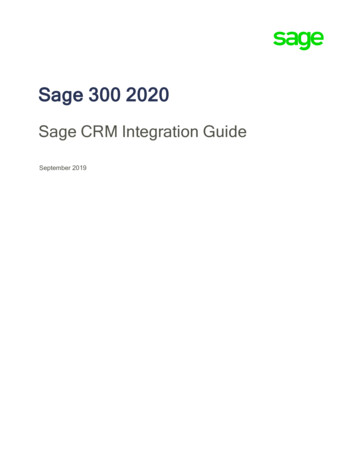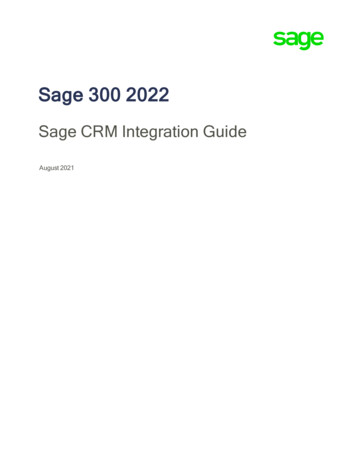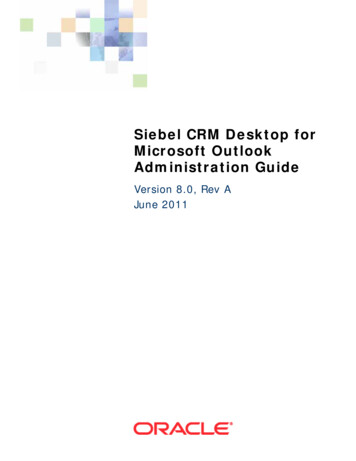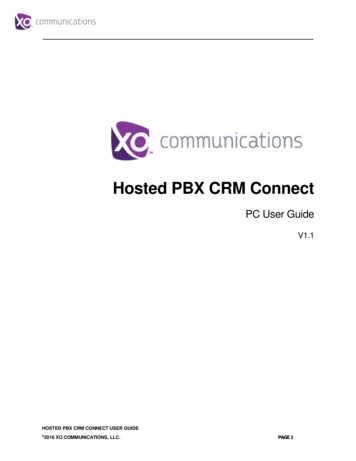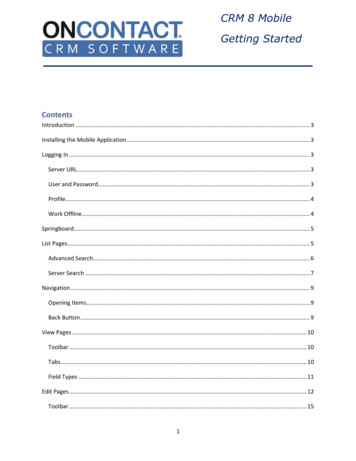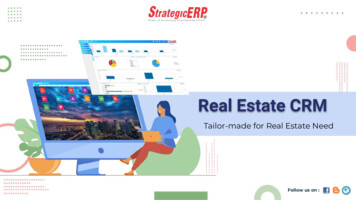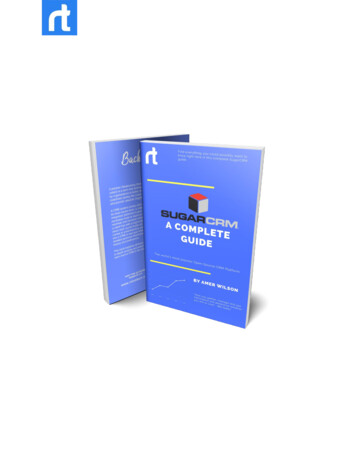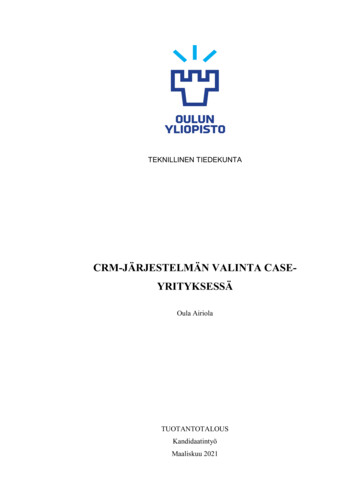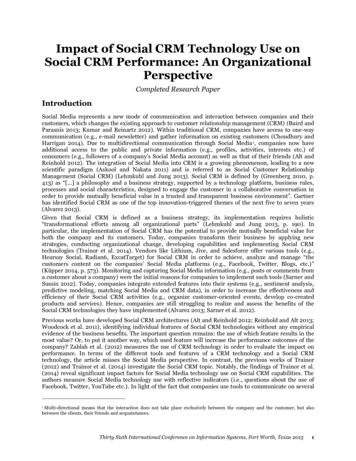
Transcription
Impact of Social CRM Technology Use onSocial CRM Performance: An OrganizationalPerspectiveCompleted Research PaperIntroductionSocial Media represents a new mode of communication and interaction between companies and theircustomers, which changes the existing approach to customer relationship management (CRM) (Baird andParasnis 2013; Kumar and Reinartz 2012). Within traditional CRM, companies have access to one-waycommunication (e.g., e-mail newsletter) and gather information on existing customers (Choudhury andHarrigan 2014). Due to multidirectional communication through Social Media 1, companies now haveadditional access to the public and private information (e.g., profiles, activities, interests etc.) ofconsumers (e.g., followers of a company’s Social Media account) as well as that of their friends (Alt andReinhold 2012). The integration of Social Media into CRM is a growing phenomenon, leading to a newscientific paradigm (Askool and Nakata 2011) and is referred to as Social Customer RelationshipManagement (Social CRM) (Lehmkuhl and Jung 2013). Social CRM is defined by (Greenberg 2010, p.413) as “[ ] a philosophy and a business strategy, supported by a technology platform, business rules,processes and social characteristics, designed to engage the customer in a collaborative conversation inorder to provide mutually beneficial value in a trusted and transparent business environment”. Gartnerhas identified Social CRM as one of the top innovation-triggered themes of the next five to seven years(Alvarez 2013).Given that Social CRM is defined as a business strategy, its implementation requires holistic“transformational efforts among all organizational parts” (Lehmkuhl and Jung 2013, p. 190). Inparticular, the implementation of Social CRM has the potential to provide mutually beneficial value forboth the company and its customers. Today, companies transform their business by applying newstrategies, conducting organizational change, developing capabilities and implementing Social CRMtechnologies (Trainor et al. 2014). Vendors like Lithium, Jive, and Salesforce offer various tools (e.g.,Hearsay Social, Radian6, ExcatTarget) for Social CRM in order to achieve, analyze and manage “thecustomers content on the companies’ Social Media platforms (e.g., Facebook, Twitter, Blogs, etc.)”(Küpper 2014, p. 573). Monitoring and capturing Social Media information (e.g., posts or comments froma customer about a company) were the initial reasons for companies to implement such tools (Sarner andSussin 2012). Today, companies integrate extended features into their systems (e.g., sentiment analysis,predictive modeling, matching Social Media and CRM data), in order to increase the effectiveness andefficiency of their Social CRM activities (e.g., organize customer-oriented events, develop co-createdproducts and services). Hence, companies are still struggling to realize and assess the benefits of theSocial CRM technologies they have implemented (Alvarez 2013; Sarner et al. 2012).Previous works have developed Social CRM architectures (Alt and Reinhold 2012; Reinhold and Alt 2013;Woodcock et al. 2011), identifying individual features of Social CRM technologies without any empiricalevidence of the business benefits. The important question remains: the use of which feature results in themost value? Or, to put it another way, which used feature will increase the performance outcomes of thecompany? Zablah et al. (2012) measures the use of CRM technology in order to evaluate the impact onperformance. In terms of the different tools and features of a CRM technology and a Social CRMtechnology, the article misses the Social Media perspective. In contrast, the previous works of Trainor(2012) and Trainor et al. (2014) investigate the Social CRM topic. Notably, the findings of Trainor et al.(2014) reveal significant impact factors for Social Media technology use on Social CRM capabilities. Theauthors measure Social Media technology use with reflective indicators (i.e., questions about the use ofFacebook, Twitter, YouTube etc.). In light of the fact that companies use tools to communicate on severalMulti-directional means that the interaction does not take place exclusively between the company and the customer, but alsobetween the clients, their friends and acquaintances.1Thirty Sixth International Conference on Information Systems, Fort Worth, Texas 20151
Social Media and Digital CollaborationsSocial Media channels with different Social Media accounts, the previous approach covers a customerperspective instead of a company perspective. Thus, the evidence regarding a corresponding approach tolink Social CRM technology use to Social CRM performance is still missing from the scholarly literature.However, a clearly defined research gap can be stated: no article investigates and evaluates the impact ofSocial CRM technology use on Social CRM performance from an organizational perspective withformative indicators. With regard to the level of attention in the current literature, formative indicators(in contrast to reflective indicators) provide detailed insight into the topic under study, which can lead toactionable affordances for companies (Mathieson et al. 2001). Given the novelty of the topic, the objectiveof the present article is to evaluate the impact of Social CRM technology use on Social CRM performance.To achieve the stated objective, the article develops and evaluates a structural model based on theresource-based view and the capability perspective, deriving three hypotheses from the literature.Accordingly, data from a survey sample of 122 marketing, communication and IT decision makers fromdifferent companies is analyzed through a structural equation model, as proposed by Hair et al. (2013).The results show that Social CRM technology use has a significant impact on capabilities, which in turnhave a direct impact on Social CRM performance.The remainder of the paper is structured as follows. The theoretical background is introduced, including abrief description of the resource-based view and the capability perspective. The hypotheses are derived inthe next section and the conceptual model is illustrated, followed by a description of the methodology.Next, the results of the evaluated model are highlighted regarding the supported as well as theunsupported hypotheses. The results are discussed in the next section. The theoretical contributions andpractical implications are explained. Finally, the conclusion, limitations and avenues for further researchare stated.Theoretical BackgroundThe resource-based view (RBV) (Barney 1991) and the capability perspective (Day 1994) serve as thetheoretical background for the article. Regarding the resource-based view, Barney (1991) stated thatvaluable, rare, inimitable, and non-substitutable resources lead to competitive advantage (e.g.,performance). “Resources can be specified as tangibles and intangibles that are used by organizations”(Keramati et al. 2010, p. 1172). Tangibles are the physical assets of a company (Rapp et al. 2010; Trainoret al. 2014) and are, especially in the Information System (IS) domain, consistent to technology (Chuangand Lin 2013; Melville and Kraemer 2004). In contrast, intangibles are specified as knowledge (e.g.,human resources) and business resources (e.g., management approaches) (Chuang and Lin 2013; Rapp etal. 2010; Trainor et al. 2014). However, the literature reveals that resources are not sufficient to improvethe performance of a company (e.g., Akroush et al. 2011; Coltman et al. 2011; Melville and Kraemer2004). Improved performance stems from capabilities, which are assembled from the company’sresources (Trainor 2012). Capabilities are specified as a company’s ability to assemble, integrate anddeploy resources in order to improve performance (Day 1994; Eisenhardt and Martin 2000; Teece et al.1997). On the one hand, capabilities are understood as an organizational repeatable pattern (i.e.,processes) (Chang et al. 2010) and on the other hand, they are referred to as infrastructural aspects (e.g.,IT skills) (Chang et al. 2010; Trainor et al. 2014). Concerning the competitive advantages (e.g.,performance), the article focuses on performance dimensions (e.g., Keramati et al. 2010). Acorresponding performance measure is described as a business activity, regarding the effectiveness, or theresults to be achieved. Thus, a performance measure “can be expressed either in terms of the actualefficiency and/or effectiveness of an action, or in terms of the end result of that action” (Neely et al. 1995,p. 110). Literature within the CRM (e.g., Rapp et al. 2010) and Information System (IS) domain (e.g.,Melville and Kraemer 2004) has drawn on the RBV to investigate how resources influence capabilities,which are proposed to improve performance.A rigorous analysis of the academic literature yields a total of 105 articles. The focus of the analysis is onempirical models within the context of Social CRM as well as on CRM, Social Media and IS, in order toidentify significant effects. After selecting current literature (published after 2009) and analyzing thecontent, 14 relevant articles are identified. The analysis of the relevant articles includes the type ofmeasurement (i.e., reflective vs. formative indicators), the theoretical background and the topic understudy (e.g., Social CRM, CRM). An overview of these previous works is presented in Table 1. In contrast tothe previous works, three major differences can be stated. First, this study evaluates all dimensions from2Thirty Sixth International Conference on Information Systems, Forth Worth, Texas 2015
Impact of Social CRM Technology Use on Performancean organizational perspective. Second, all indicators are measured formatively. Finally, based on thetheoretical background, no article investigates different performance dimensions for Social CRM.Table 1. Overview of the literatureReferencesType ofmeasureTheory backgroundTopic of the resource constructRefl.Form. RBV Cap. Lit.RMT SCTISCRMSMSCRMWang and Feng (2012)xxxxZablah et al. (2012)x1x2xxErnst et al. (2011)x1x2xxTrainor et al. (2014)xxxxChang et al. (2010)xxxxRapp et al. (2010)xxxxHarrigan et al. (2010)xxxChoudhury and Harriganxxxx(2014)Keramati et al. (2010)xxxxAbdul-Muhmin (2012)xxxChuang and Lin (2013)xxxxAkroush et al. (2011)xxxRodriguez et al. (2012)xxxColtman et al. (2011)xxxxSum1327822111020This articlexxxxRefl. reflective; Form. formative; RBV resource-based view; Cap. capability perspective; Lit. literaturegrounded; RMT relationship marketing theory, SCT social capital theory; SM social media; x1 dependentvariable; x2 independent variableBased on prior research activities and theoretical support, this article focuses on Social CRM technologyuse for the resource dimension for three reasons. First, this is the first empirically evaluated model forSocial CRM technology use from an organizational perspective (i.e., evaluating Social CRM technologyfeatures). Second, due to the IS domain, the most valuable asset (see definition of resources) for acompany is the use of new technology (i.e., Social CRM technology use) (Abdul-Muhmin 2012; Rodriguezet al. 2012). Finally, a specification of the resources generates deeper insights within an organization,which enables the researcher to derive specific affordances for practice (e.g., Chang et al. 2010; Zablah etal. 2012). In sum, three dimensions are used for further analysis: Social CRM technology use, Social CRMcapabilities and Social CRM performance.Hypothesis Development and Conceptual ModelSocial CRM Technology UseInformation technology and information systems (IS) use are both widely and vividly discussed topicswithin the discipline of IS research. Venkatesh et al. (2003) highlight two relevant perspectives:intentions to use information technology and actual use of information technology. According toBhattacherjee et al. (2008), the former investigates the user’s initial or first-time decision to use IT, orrather the construct “intention to use” within the technology acceptance model (TAM) (Davis et al. 1989;Venkatesh and Bala 2008; Venkatesh and Davis 2000; Venkatesh et al. 2003). The latter focuses on thepost-adoption behaviors, for example continuous behavior (Bhattacherjee et al. 2008), IS continuanceusage (Limayem et al. 2007) or system use (Venkatesh et al. 2008). To clarify, the article focuses on theactual use of an information technology. According to Petter et al. (2007), all recommended constructs aremeasured with reflective indicators. Due to the specific research topic (Social CRM) and the formativemeasurement in this study, the CRM and the Social Media literature also need to be considered. Withinthe CRM as well as the Social Media context, information technology use is a central component. CRMtechnology is understood as the automation of internal (e.g., among employees like Sales-, Marketingpeople) and external information processing (e.g., communication with consumers through IT such as email, supported by systems for customer analytics) (Trainor et al. 2014). Due to the lack of a definition ofThirty Sixth International Conference on Information Systems, Forth Worth, Texas 20153
Social Media and Digital CollaborationsSocial CRM technology use in the literature, the authors adopt a previous CRM definition from Zablah etal. (2012). Thus, Social CRM technology use is defined as the degree to which Social CRM technologyfeatures are being utilized to support organizational work. Regarding the definition, a necessary first stepin assessing the degree of a company’s Social CRM technology use is to identify the corresponding SocialCRM technology features, as recommended by Burton-Jones and Straub (2006). 2 A previousclassification, adapted from the works of, for example, Alt and Reinhold (2012), Reinhold and Alt (2013),and Woodcock et al. (2011), highlights six categories of tool features (i.e., first-order constructs), namelymonitoring and capturing, analysis, exploitation, communication, management-controlling, and ISintegration. Further analysis groups these six categories into two superordinary dimensions (i.e., secondorder constructs), named processing and management, which determine the resource dimension SocialCRM technology use (i.e., third-order construct).The scholarly literature reveals that technology use has a positive influence on capabilities. Thisconclusion is supported by Chang et al. (2010), Chuang and Lin (2013), Keramati et al. (2010), Rapp et al.(2010), and Wang and Feng (2012), who all found positive significant relationships within the context ofCRM. The positive and significant relationship between Social Media or IS technology use and capabilitiesis supported by the contributions of Abdul-Muhmin (2012), Harrigan et al. (2010), Rodriguez et al.(2012), and Trainor et al. (2014). Thus, the first hypothesis is as follows:H1: Social CRM technology use has a positive relationship with Social CRM capability.Current literature within the Social Media context has stated that the use of Facebook, Twitter, andYouTube have a moderated effect on a company’s capabilities (Rodriguez et al. 2012; Trainor et al. 2014).The relationship of technology use with capabilities will be positively influenced by the use of differentSocial Media accounts. A company with a portfolio of Social Media accounts is able to capture, analyze etc.more relevant data through the use of Social CRM technologies (e.g., the use of Facebook and Twitter hasa higher influence on the relationship than just the use of a YouTube channel). Thus, the secondhypothesis is stated:H2: Social Media use has a positive influence of the relationship between Social CRM technology use andSocial CRM capability.Social CRM CapabilityBased on the abovementioned specification of capability, the authors follow a previous definitionrecommended by Trainor et al. (2014). Thus, Social CRM capabilities are defined as customer-facingactivities, including processes and infrastructural aspects in the context of Social Media data designed toengage customers in collaborative conversations and so enhance customer relationships. This articleadopts the measurement framework of Kim and Kim (2009), which covers an infrastructural and aprocess dimension as antecedences for performance dimensions. Three reasons for the adoption can bestated. First, the model was selected after a rigorous and systematic literature review. Second, theframework was published in a highly ranked journal and is widely used3, which provides a high degree ofexternal validity. Finally, the framework was discussed in two focus groups with practitioners and it couldbe stated that it is very comprehensive and easy to communicate. The differentiation of process andinfrastructural capabilities (i.e., second-order constructs) is also stated by Keramati et al. (2010),Choudhury and Harrigan (2014), and Coltman et al. (2011). Process capabilities describe aspects thatrelate to company-wide, as well as department-specific processes (serve as first-order constructs) ofSocial CRM (Keramati et al. 2010). In contrast, infrastructure capability describes activities and/orresults of infrastructural aspects (Neely et al. 1995), which includes an IT dimension, for example ITreadiness, and a cultural dimension (serve as first-order constructs) (Chang et al. 2010; Chuang and Lin2013). Both second-order constructs determine the overall capability dimension Social CRM capability(i.e., third-order construct). The literature reveals a positive relationship between Social CRM capabilitiesand performance. For example, through target-oriented customer events, new customer insights, or betterBurton-Jones and Straub (2006) highlights two relevant elements, which still have to be investigated, in this context: first, thesystem (here: Social CRM technology) that is being used and, second, the function (here: the feature) that is being performed.2According to Google Scholar, it is the most cited article for the abovementioned CRM performance measurement models as ofOctober 2014.34Thirty Sixth International Conference on Information Systems, Forth Worth, Texas 2015
Impact of Social CRM Technology Use on Performancecustomer interactions a company can interact more effectively and efficiently with customers (Trainor etal. 2014). In particular, the literature supports positive and significant coefficients of capabilities tocustomer performance within the CRM, Social Media and IS context (Chuang and Lin 2013;Jayachandran et al. 2005; Keramati et al. 2010; Rapp et al. 2010; Trainor et al. 2014). The literature alsoreveals positive and significant relationships with company performance. Thus, the results within theCRM and IS contexts from Chang et al. (2010), Coltman et al. (2011), Ernst et al. (2011), Harrigan et al.(2010), Keramati et al. (2010), Reinartz et al. (2004), and Wang and Feng (2012) provide strong supportfor the next hypothesis:H3: Social CRM capability has a positive relationship with Social CRM performance.Social CRM PerformanceThe scholarly literature lacks a clear definition of Social CRM performance. Thus, the following definitionof performance is adapted, as recommend by Lebas (1995): Social CRM performance is defined as thepotential for successful implementation of Social CRM activities in order to achieve business objectives.On the one hand, an objective can be customer related, for example increasing customer loyalty online by10%. On the other hand, an objective can be company related, for example increasing the success of newlyintroduced products by 5%. Therefore, the article adopts the two performance dimensions from Kim andKim (2009), namely customer performance and company performance (second-order constructs). Thisdifferentiation is also stated in the articles of Rapp et al. (2010) and Zablah et al. (2012). The customerperformance describes the effects of Social CRM on the customers (customer perception) and the aspectsof Social CRM, which are perceived by customers (Trainor et al. 2014). Additionally, it includes directaspects, for example the company has to operate actively, as well as indirect aspects (serve as first-orderconstructs), for example the management activities of a company. In contrast, the company performancedescribes the dimension of the company’s success and business results (Wang and Feng 2012; Zablah etal. 2012). In particular, the constructs include monetization aspects, for example financial benefits andcustomer lifetime value, as well as non-monetization aspects (serve as first-order constructs), for examplebrand awareness and competitive advantage, in order to establish a long-term and profitable customerrelationship. Both second-order constructs determine the overall performance dimension Social CRMperformance (i.e., third-order construct).Figure 1. Conceptual ModelBased on the theoretical background and the three derived hypotheses, the conceptual model is presentedin Figure 1. A covariate, namely company size, is added for Social CRM capability and Social CRMThirty Sixth International Conference on Information Systems, Forth Worth, Texas 20155
Social Media and Digital Collaborationsperformance in order to control for the dependent variables in the conceptual model, as proposed byReinartz et al. (2004), Trainor et al. (2014) and Zablah et al. (2012).MethodInstrument DevelopmentTo test the conceptual model, formative as well as reflective indicators (as quality criteria) are used. Theprocess of developing instruments (i.e., indicators) is depicted in Figure 2 (Walther et al. 2013). It isconducted following a three stage approach (I. item creation, II. scale development and III. indicatortesting), including a total of six sub-stages, as proposed by Moore and Benbasat (1991).Figure 2. Process of Developing InstrumentsThe first sub-stage “Conceptualization Content Specification” focuses on a literature review in order toidentify context-specific constructs (dimensions), as well as the corresponding sub-dimensions andindicators (e.g., performance measures and Social CRM technology features). Second (“ItemGeneration”), based on the results, indicators are deduced to operationalize the previous constructs. Thisled to an initial set of 41 formative indicators (11 performance, 12 capability and 18 technology usemeasures) and 8 reflective indicators. Third, a Q-sorting procedure assesses the “Access Content Validity”for the formative indicators with the calculation of an inter-rater reliability index (or related indexes, e.g.,Cronbach’s Alpha). The present study therefore follows Petter et al. (2007), who stated that contentvalidity for reflective indicators does not have strong validatory power, but is essential when usingformative indicators and corresponding constructs. “Content validity assesses whether the researcher haschosen measures that appropriately capture the full domain of the construct” (Petter et al. 2007). Insequentially independent rounds, a master’s student, two PhD students in the discipline of IS and onepractitioner from the corresponding operative departments classified the indicators according to theconstructs. Participants are encouraged to carefully read the definitions of the constructs, and thenclassify the formative indicators within the appropriate construct. After each round, inter-rater reliability,following Perreault and Leigh's formula (1989), raw agreement and a placement ratio are calculated inorder to identify problem areas (e.g., in the definitions, wording etc.). The content validation stops whenall ratios fall within the generally accepted range of 0.8 – 1.0. After each round, the problems areeradicated, and the indicators are re-written or even totally re-defined to improve understandability.Discrepancies are always reviewed, discussed and clarified with an independent focus group ofresearchers and one professor. For the performance and capability formative indicators, all ratios wereclearly above the threshold after the third round. Comparably, the ratios for the technology use formativeindictors were above the threshold after the second round. Within the next sub-stage (“Pretest andRefinement”), the questionnaire was distributed online to PhD students and four selected practitioners inthe appropriate Social CRM context. After some cuts to the introduction, the practitioners stated thatscreen-out questions are required. These are questions that ensure only suitable people complete thequestionnaire. Therefore, two initial questions were generated. 4 The “Field Test” (sub-stage five) wasconducted with n 10 completes in order to obtain some initial feedback, check technical aspects andFirst, “Does your company use Social Media?” and second, “Do you work in a related department or have a decision-makingfunction enabling you to answer questions about Social CRM performance and Social CRM technology?”46Thirty Sixth International Conference on Information Systems, Forth Worth, Texas 2015
Impact of Social CRM Technology Use on Performancecalculate the time that practitioners need to complete the questionnaire. No technical complaints or issueswith the length of the questionnaire arose. Particularly for the unique characteristics of formativeindicators and the corresponding constructs, the last sub-stage “Evaluation of Formative MeasurementModel and Re-Specification” is based on the process of formative measurements from Cenfetelli andBassellier (2009). The applied confirmatory factor analysis is designed according to Diamantopoulos andWinklhofer (2001), and focuses on a statistical evaluation of formative indicators and correspondingconstructs (see “Measurement Model” section).Data SampleThe complete survey was launched in August 2014. It was only available online and distributed over SocialMedia (e.g., Xing, LinkedIn, Twitter), focusing on marketing, communication and IT decision makers.The indicators were measured using a 7-point Likert scale ranging from “strongly disagree” (1) to“strongly agree” (7). After four months, a total of n 126 respondents completed the survey. Due to fourincomplete questionnaires (i.e., missing data), data from n 122 participants was captured and serves asthe basis for further analysis. Due to the distribution via Social Media channels, no response rate could becalculated. Table 2 presents an overview of the sample characteristics by industry sector, position withinthe company and number of employees.Table 2. Overview of Sample CharacteristicsIndustryManufacturing & UtilityOthersInformation & CommunicationFinance & InsurancePublic Administration & LogisticsHealth IndustryPercent31.1%18.0%14.8%13.9%11.5%10.7%# of Employees 1010 – 4950 – 499500 – 9991000 – 5000 5000Percent16.4%17.2%28.7%9.8%16.4%11.5%Position in CompanyExecutivesTeam ManagerSpecialized ManagerDepartment ManagerDivision ata AnalysisThe prerequisite step to analyzing the structural model is the evaluation of the measurement model,which is calculated using the statistical software SmartPLS and SPSS (e.g., calculation of the varianceinflation factor). In particular, the coefficients of the corresponding relationships are estimated byconducting a structural equation model with a partial least square (PLS) method (Hair et al. 2013). Themoderating effect (Social Media use) is analyzed using hierarchical regression analysis with SPSS, whichis the most common approach (Gounaris et al. 2010). In order to gain a deeper insight and interpret itsform, the moderating effect was plotted with a mean centered variable of Social CRM technology use,according to Aiken and West (1991).The variance-based approach to analyzing the structural model is chosen for three reasons. First, the PLSmethod is well-suited to analyzing small to medium sample sizes, providing a bootstrapping function forthe test statistics (e.g., t-values) (Hulland 1999). Second, the PLS method estimates coefficients and teststatistics without requiring a distributional assumption, which is important for Likert scale data (Chin2010; Fornell and Larcker 1981). Finally, all indicators are measured formatively and with higher orderconstructs (i.e., first-, second-, and third-order constructs), which is well-supported by a structuralequation model with a PLS method (Cenfetelli and Bassellier 2009; Wetzels et al. 2009).ResultsThe estimators from the partial least square method are reported, as recommended by Hair et al. (2013),in a two-step approach (Chin 2010). First, the measurement model is calculated. The reflectivemeasurement model is reported as provided by Söllner et al. (2012) for the four second-order constructsof process capability, infrastructure capability, customer performance and company performance. Toclarify, the second-order constructs for Social CRM technology use and all third-order constructs areformatively measured as higher-order constructs. The development process of the formatively measuredindicators and the corresponding constructs follows the five steps recommended by Cenfetelli andBassellier (2009), applying a confirmatory factor analysis (Diamantopoulos and Winklhofer 2001).Thirty Sixth International Conference on Information Systems, Forth Worth, Texas 20157
Social Media and Digital CollaborationsSecond, the coefficients of the structural model are calculated (Hair et al. 2013) and two quality criteriaare presented (i.e., f2, R2) (Gefen et al. 2011; Hair et al. 2011; Wetzels et al. 2009). The estimations arecalculated with a parameter setting using 120 cases and 3000 samples.Measurement ModelThe reflective measurement model is assessed by estimating (1) convergent validity (i.e., AVE and factorloadings), (2) internal consistency (i.e., composite reliability) and (3) discriminant validity (Hair et al.2013). Appendix A provides an overview of the test statistics. The indicators show (1) a satisfactoryconvergent validity as a
Social CRM technology use from an organizational perspective (i.e., evaluating Social CRM technology features). Second, due to the IS domain, the most valuable asset (see definition of resources) for a . (Limayem et al. 2007) or system use (Venkatesh et al. 2008). To clarify, the article focuses on the actual use of an information technology .

